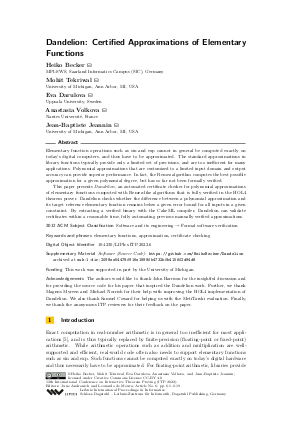@InProceedings{becker_et_al:LIPIcs.ITP.2022.6,
author = {Becker, Heiko and Tekriwal, Mohit and Darulova, Eva and Volkova, Anastasia and Jeannin, Jean-Baptiste},
title = {{Dandelion: Certified Approximations of Elementary Functions}},
booktitle = {13th International Conference on Interactive Theorem Proving (ITP 2022)},
pages = {6:1--6:19},
series = {Leibniz International Proceedings in Informatics (LIPIcs)},
ISBN = {978-3-95977-252-5},
ISSN = {1868-8969},
year = {2022},
volume = {237},
editor = {Andronick, June and de Moura, Leonardo},
publisher = {Schloss Dagstuhl -- Leibniz-Zentrum f{\"u}r Informatik},
address = {Dagstuhl, Germany},
URL = {https://drops.dagstuhl.de/entities/document/10.4230/LIPIcs.ITP.2022.6},
URN = {urn:nbn:de:0030-drops-167155},
doi = {10.4230/LIPIcs.ITP.2022.6},
annote = {Keywords: elementary functions, approximation, certificate checking}
}

 Creative Commons Attribution 4.0 International license
Creative Commons Attribution 4.0 International license










